SUZUKI ALTO 2020 Manual PDF
Manufacturer: SUZUKI, Model Year: 2020, Model line: ALTO, Model: SUZUKI ALTO 2020Pages: 139, PDF Size: 2.22 MB
Page 71 of 139
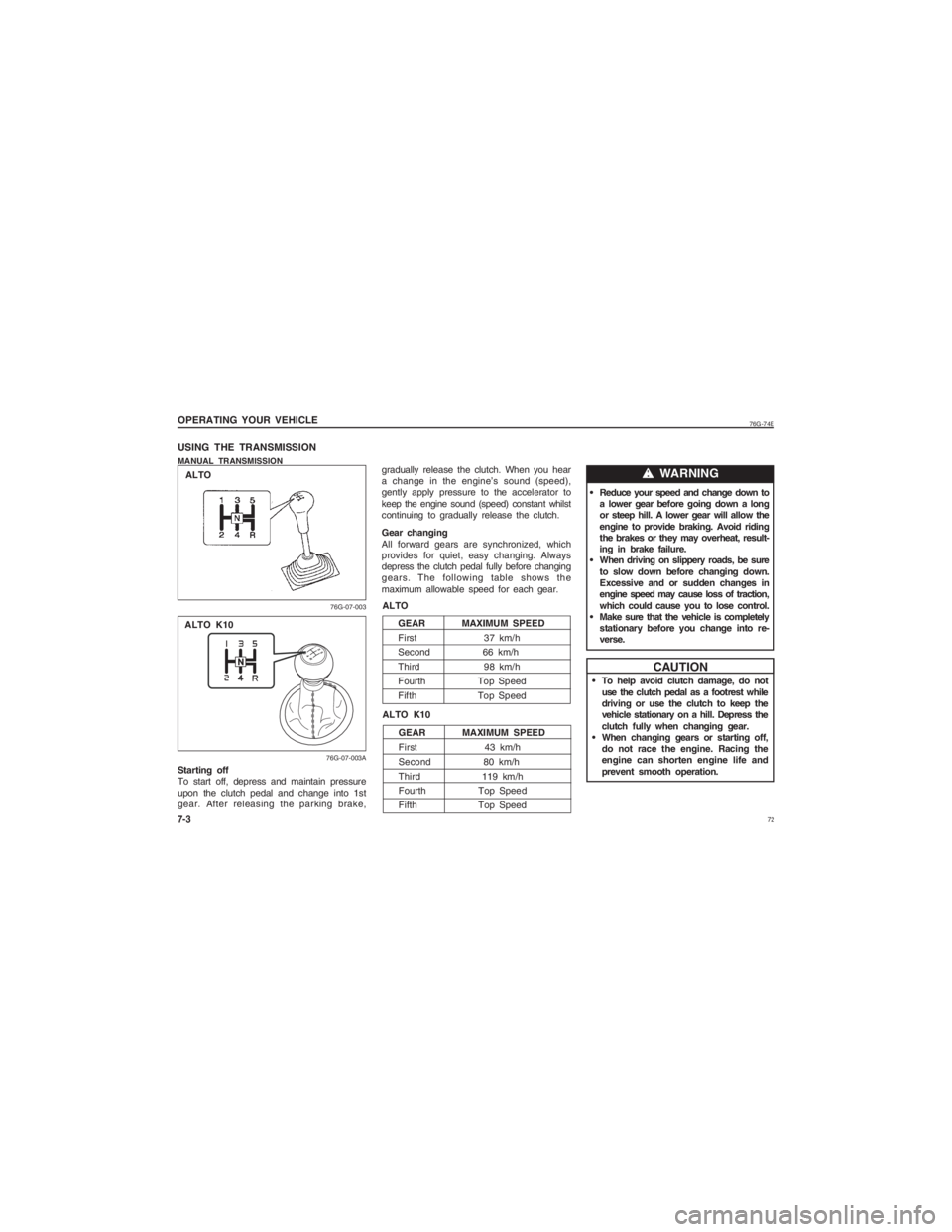
72
76G-74E
7-3OPERATING YOUR VEHICLE
ww ww
w WARNINGCAUTION
Starting off
To start off, depress and maintain pressure
upon the clutch pedal and change into 1st
gear. After releasing the parking brake, GEAR MAXIMUM SPEED
First 37 km/h
Second 66 km/h
Third 98 km/h
Fourth Top Speed
Fifth
Top SpeedUSING THE TRANSMISSIONMANUAL TRANSMISSION
76G-07-00376G-07-003A
To help avoid clutch damage, do not
use the clutch pedal as a footrest while
driving or use the clutch to keep the
vehicle stationary on a hill. Depress the
clutch fully when changing gear.
When changing gears or starting off,
do not race the engine. Racing the
engine can shorten engine life and
prevent smooth operation.
Reduce your speed and change down to
a lower gear before going down a long
or steep hill. A lower gear will allow the
engine to provide braking. Avoid riding
the brakes or they may overheat, result-
ing in brake failure.
When driving on slippery roads, be sure to slow down before changing down.
Excessive and or sudden changes in
engine speed may cause loss of traction,
which could cause you to lose control.
Make sure that the vehicle is completely
stationary before you change into re-
verse.
gradually release the clutch. When you hear
a change in the engine’s sound (speed),
gently apply pressure to the accelerator to
keep the engine sound (speed) constant whilst
continuing to gradually release the clutch.
Gear changing
All forward gears are synchronized, which
provides for quiet, easy changing. Always
depress the clutch pedal fully before changing
gears. The following table shows the
maximum allowable speed for each gear.
ALTO
ALTO K10
GEAR MAXIMUM SPEED
First 43 km/h
Second 80 km/h
Third 119 km/h
Fourth Top Speed
Fifth Top Speed
ALTO
ALTO K10
Page 72 of 139
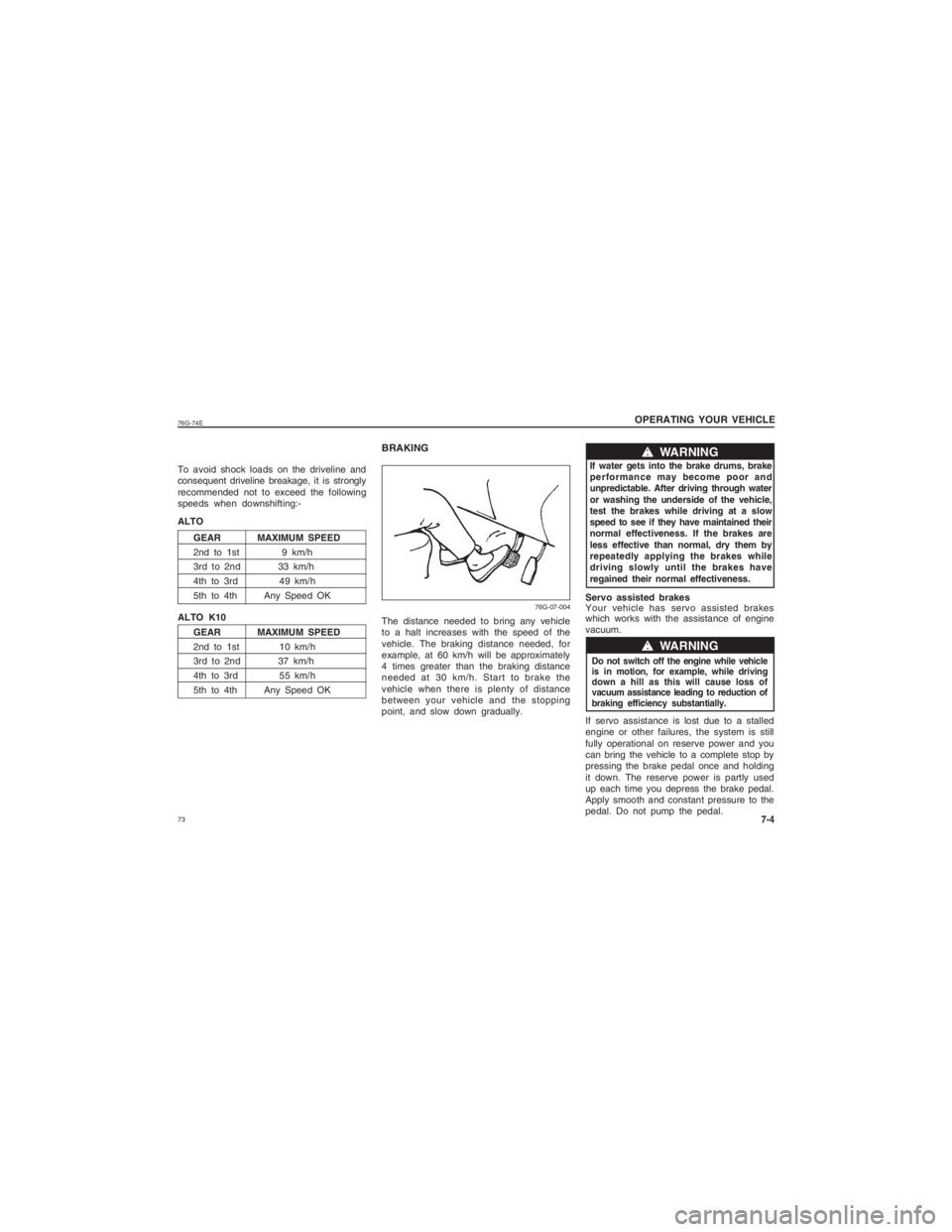
7376G-74E
7-4
OPERATING YOUR VEHICLE
BRAKINGww ww
w WARNING
The distance needed to bring any vehicle
to a halt increases with the speed of the
vehicle. The braking distance needed, for
example, at 60 km/h will be approximately
4 times greater than the braking distance
needed at 30 km/h. Start to brake the
vehicle when there is plenty of distance
between your vehicle and the stopping
point, and slow down gradually.
If water gets into the brake drums, brake
performance may become poor and
unpredictable. After driving through water
or washing the underside of the vehicle,
test the brakes while driving at a slow
speed to see if they have maintained their
normal effectiveness. If the brakes are
less effective than normal, dry them by
repeatedly applying the brakes while
driving slowly until the brakes have
regained their normal effectiveness.Servo assisted brakes
Your vehicle has servo assisted brakes
which works with the assistance of engine
vacuum.Do not switch off the engine while vehicle
is in motion, for example, while driving
down a hill as this will cause loss of
vacuum assistance leading to reduction of
braking efficiency substantially.If servo assistance is lost due to a stalled
engine or other failures, the system is still
fully operational on reserve power and you
can bring the vehicle to a complete stop by
pressing the brake pedal once and holding
it down. The reserve power is partly used
up each time you depress the brake pedal.
Apply smooth and constant pressure to the
pedal. Do not pump the pedal.
ww ww
w WARNING
76G-07-004
To avoid shock loads on the driveline and
consequent driveline breakage, it is strongly
recommended not to exceed the following
speeds when downshifting:-
GEAR MAXIMUM SPEED
2nd to 1st 9 km/h
3rd to 2nd 33 km/h
4th to 3rd 49 km/h
5th to 4th Any Speed OK
ALTO
ALTO K10
GEAR MAXIMUM SPEED
2nd to 1st 10 km/h
3rd to 2nd 37 km/h
4th to 3rd 55 km/h
5th to 4th Any Speed OK
Page 73 of 139
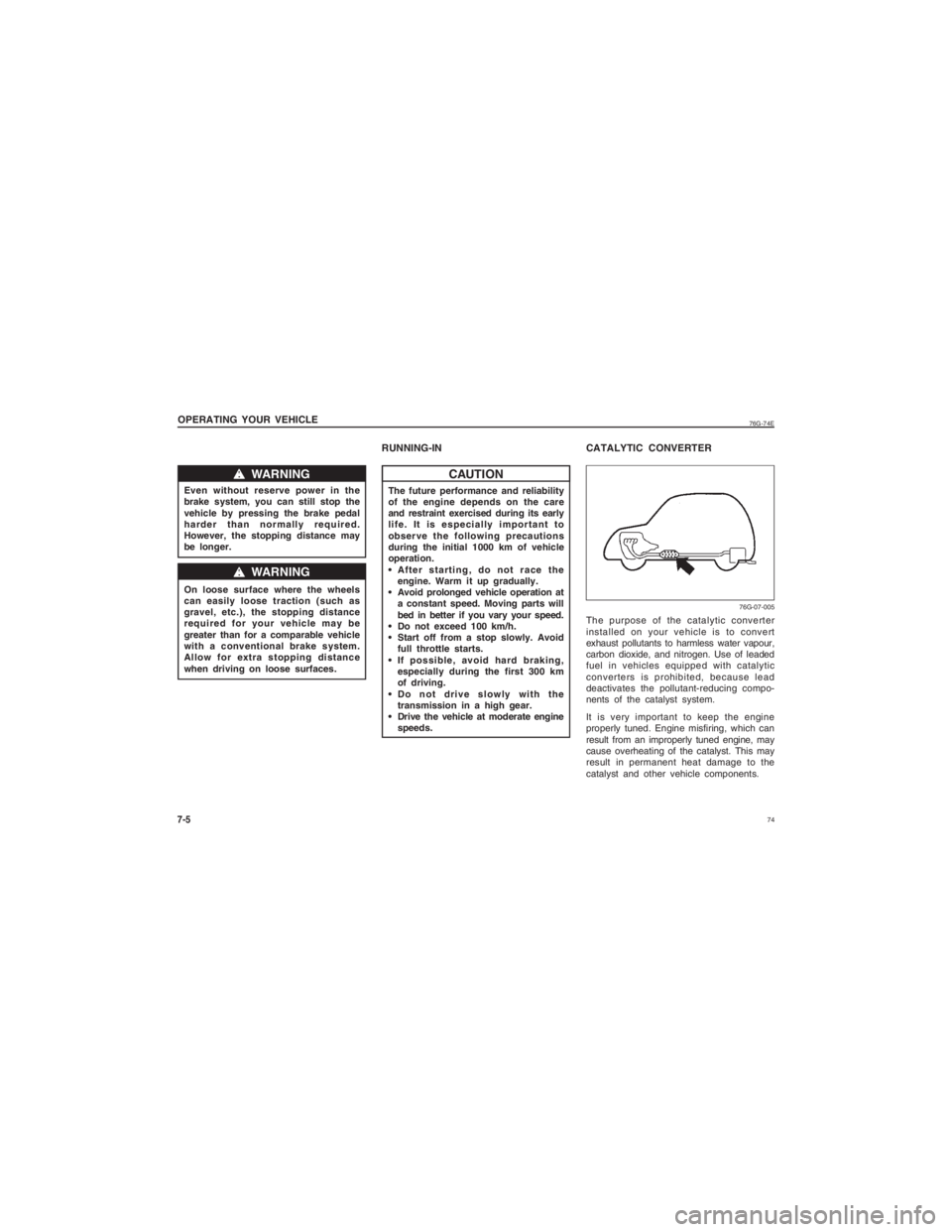
74
76G-74E
7-5OPERATING YOUR VEHICLERUNNING-IN
The future performance and reliability
of the engine depends on the care
and restraint exercised during its early
life. It is especially important to
observe the following precautions
during the initial 1000 km of vehicle
operation.
After starting, do not race theengine. Warm it up gradually.
Avoid prolonged vehicle operation at a constant speed. Moving parts will
bed in better if you vary your speed.
Do not exceed 100 km/h.
Start off from a stop slowly. Avoid full throttle starts.
If possible, avoid hard braking, especially during the first 300 km
of driving.
Do not drive slowly with the transmission in a high gear.
Drive the vehicle at moderate engine speeds.
CAUTION
Even without reserve power in the
brake system, you can still stop the
vehicle by pressing the brake pedal
harder than normally required.
However, the stopping distance may
be longer.
On loose surface where the wheels
can easily loose traction (such as
gravel, etc.), the stopping distance
required for your vehicle may be
greater than for a comparable vehicle
with a conventional brake system.
Allow for extra stopping distance
when driving on loose surfaces.
ww ww
w WARNINGww
ww
w WARNING
CATALYTIC CONVERTERThe purpose of the catalytic converter
installed on your vehicle is to convert
exhaust pollutants to harmless water vapour,
carbon dioxide, and nitrogen. Use of leaded
fuel in vehicles equipped with catalytic
converters is prohibited, because lead
deactivates the pollutant-reducing compo-
nents of the catalyst system.
It is very important to keep the engine
properly tuned. Engine misfiring, which can
result from an improperly tuned engine, may
cause overheating of the catalyst. This may
result in permanent heat damage to the
catalyst and other vehicle components.
76G-07-005
Page 74 of 139

7576G-74E
7-6
OPERATING YOUR VEHICLE
Be careful where you park and drive;
the catalytic converter and other
exhaust components can get very hot.
As with any vehicle, do not park or
operate this vehicle in areas where
combustible materials such as dry
grass or leaves can come in contact
with a hot exhaust system.
ww ww
w WARNING
To minimize the possibility of catalyst
or other vehicle damage:
Maintain the engine in the proper
operating condition.
In the event of an engine
malfunction, particularly one
involving engine misfire or other
apparent loss of performance, have
the vehicle serviced promptly.
Do not turn off the engine or interrupt the ignition when the
transmission is in gear and the
vehicle is in motion.
Do not try to start the engine by pushing or towing the vehicle, or
coasting down a hill.
Do not idle the engine with any spark plug wires disconnected or
removed, such as during diagnostic
testing.
Do not idle the vehicle for
prolonged periods if idling seems
rough or there are other
malfunctions.
Do not allow the fuel tank to get
near the empty level.
CAUTION
IMPROVING FUEL ECONOMYThe following instructions will help you
improve fuel economy.
Avoid excessive idling:
If you are to wait for more than a minute
while you are parked, stop the engine and
start it again later. When warming up a cold
engine, allow the engine to idle for some
time.
Avoid “fast” starts:
Fast starts away from lights or stop signs
will consume fuel unnecessarily and shorten
engine life. Start off slowly.
Avoid unnecessary stops:
Avoid unnecessary deceleration and
stopping. Try to maintain a slow, steady
speed whenever possible. Slowing down
and then accelerating again uses more fuel.
Keep a steady cruising speed:
Keep as constant a speed as road and
traffic conditions will permit.
76G-07-006
Page 75 of 139
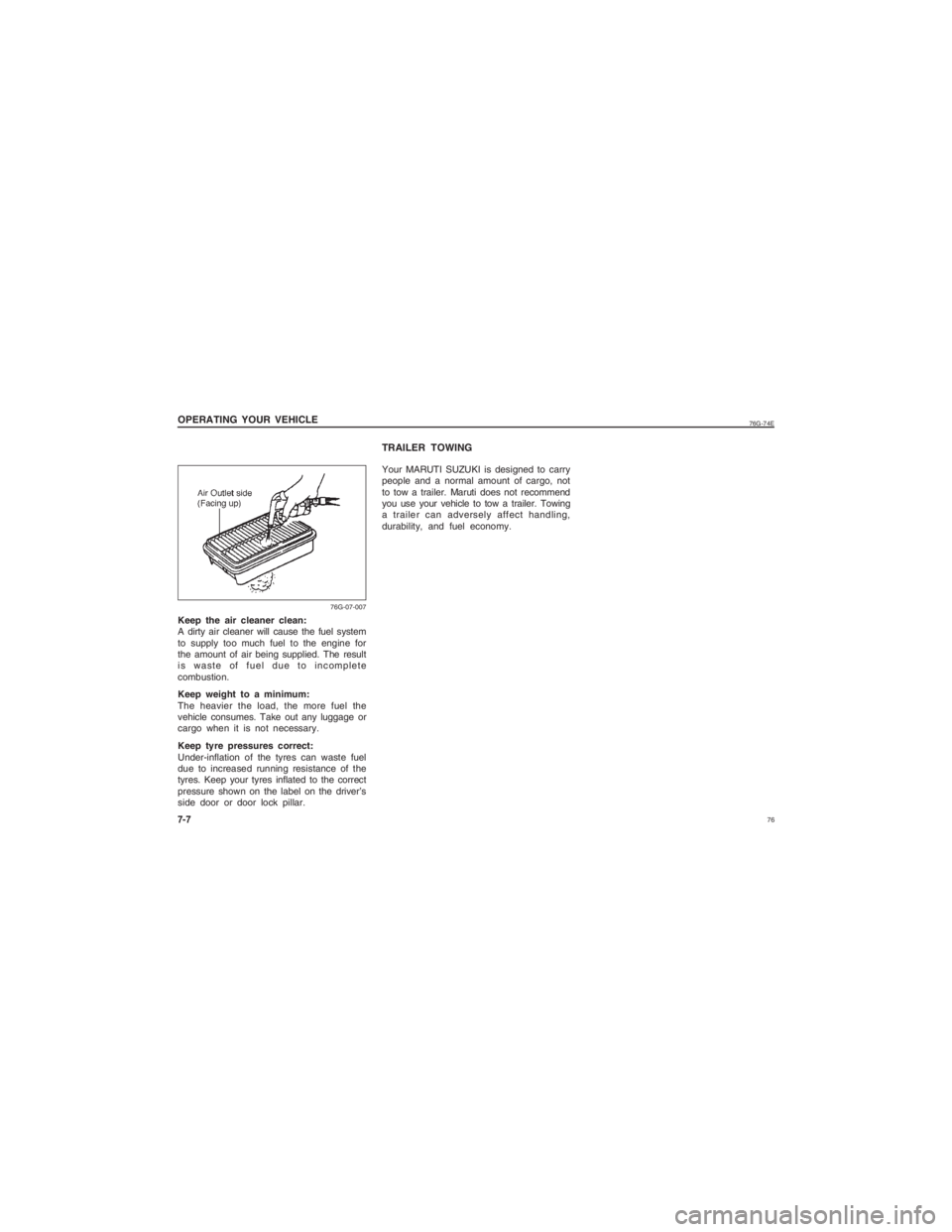
76
76G-74E
7-7
TRAILER TOWINGYour MARUTI SUZUKI is designed to carry
people and a normal amount of cargo, not
to tow a trailer. Maruti does not recommend
you use your vehicle to tow a trailer. Towing
a trailer can adversely affect handling,
durability, and fuel economy.
Keep the air cleaner clean:
A dirty air cleaner will cause the fuel system
to supply too much fuel to the engine for
the amount of air being supplied. The result
is waste of fuel due to incomplete
combustion.
Keep weight to a minimum:
The heavier the load, the more fuel the
vehicle consumes. Take out any luggage or
cargo when it is not necessary.
Keep tyre pressures correct:
Under-inflation of the tyres can waste fuel
due to increased running resistance of the
tyres. Keep your tyres inflated to the correct
pressure shown on the label on the driver’s
side door or door lock pillar.OPERATING YOUR VEHICLE
76G-07-007
Page 76 of 139
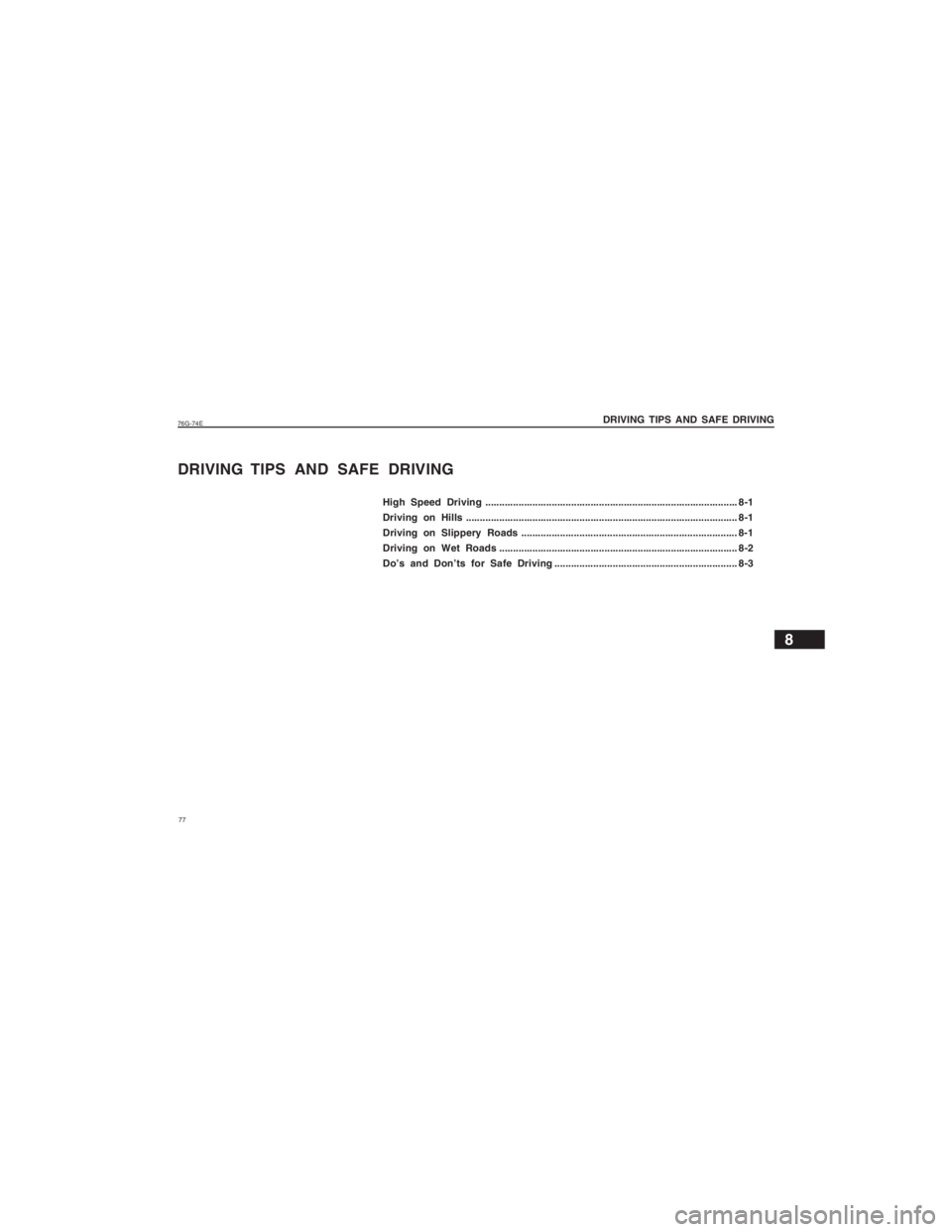
7776G-74E
DRIVING TIPS AND SAFE DRIVING
8
DRIVING TIPS AND SAFE DRIVING
High Speed Driving
........................................................................\
................... 8-1
Driving on Hills ........................................................................\
.......................... 8-1
Driving on Slippery Roads ........................................................................\
...... 8-1
Driving on Wet Roads ........................................................................\
.............. 8-2
Do’s and Don’ts for Safe Driving .................................................................. 8-3
Page 77 of 139
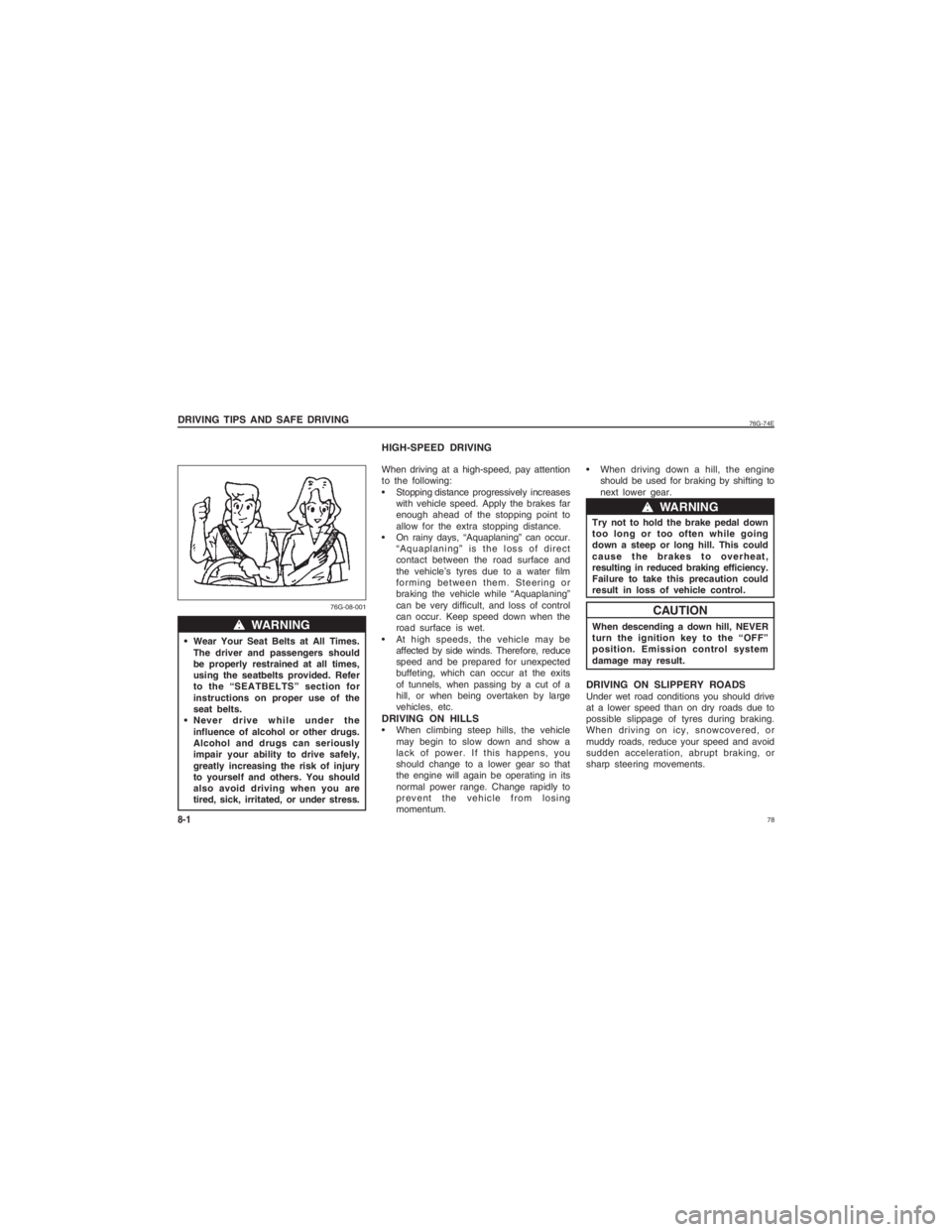
78
76G-74E
Wear Your Seat Belts at All Times.The driver and passengers should
be properly restrained at all times,
using the seatbelts provided. Refer
to the “SEATBELTS” section for
instructions on proper use of the
seat belts.
Never drive while under the
influence of alcohol or other drugs.
Alcohol and drugs can seriously
impair your ability to drive safely,
greatly increasing the risk of injury
to yourself and others. You should
also avoid driving when you are
tired, sick, irritated, or under stress.
HIGH-SPEED DRIVING
When driving down a hill, the engine should be used for braking by shifting to
next lower gear.
Try not to hold the brake pedal down
too long or too often while going
down a steep or long hill. This could
cause the brakes to overheat,
resulting in reduced braking efficiency.
Failure to take this precaution could
result in loss of vehicle control.
When descending a down hill, NEVER
turn the ignition key to the “OFF”
position. Emission control system
damage may result.DRIVING ON SLIPPERY ROADSUnder wet road conditions you should drive
at a lower speed than on dry roads due to
possible slippage of tyres during braking.
When driving on icy, snowcovered, or
muddy roads, reduce your speed and avoid
sudden acceleration, abrupt braking, or
sharp steering movements.
When driving at a high-speed, pay attention
to the following:
Stopping distance progressively increases
with vehicle speed. Apply the brakes far
enough ahead of the stopping point to
allow for the extra stopping distance.
On rainy days, “Aquaplaning” can occur. “Aquaplaning” is the loss of direct
contact between the road surface and
the vehicle’s tyres due to a water film
forming between them. Steering or
braking the vehicle while “Aquaplaning”
can be very difficult, and loss of control
can occur. Keep speed down when the
road surface is wet.
At high speeds, the vehicle may be affected by side winds. Therefore, reduce
speed and be prepared for unexpected
buffeting, which can occur at the exits
of tunnels, when passing by a cut of a
hill, or when being overtaken by large
vehicles, etc.
DRIVING ON HILLS When climbing steep hills, the vehiclemay begin to slow down and show a
lack of power. If this happens, you
should change to a lower gear so that
the engine will again be operating in its
normal power range. Change rapidly to
prevent the vehicle from losing
momentum.
ww ww
w WARNING
ww
ww
w WARNINGCAUTION
8-1DRIVING TIPS AND SAFE DRIVING
76G-08-001
Page 78 of 139
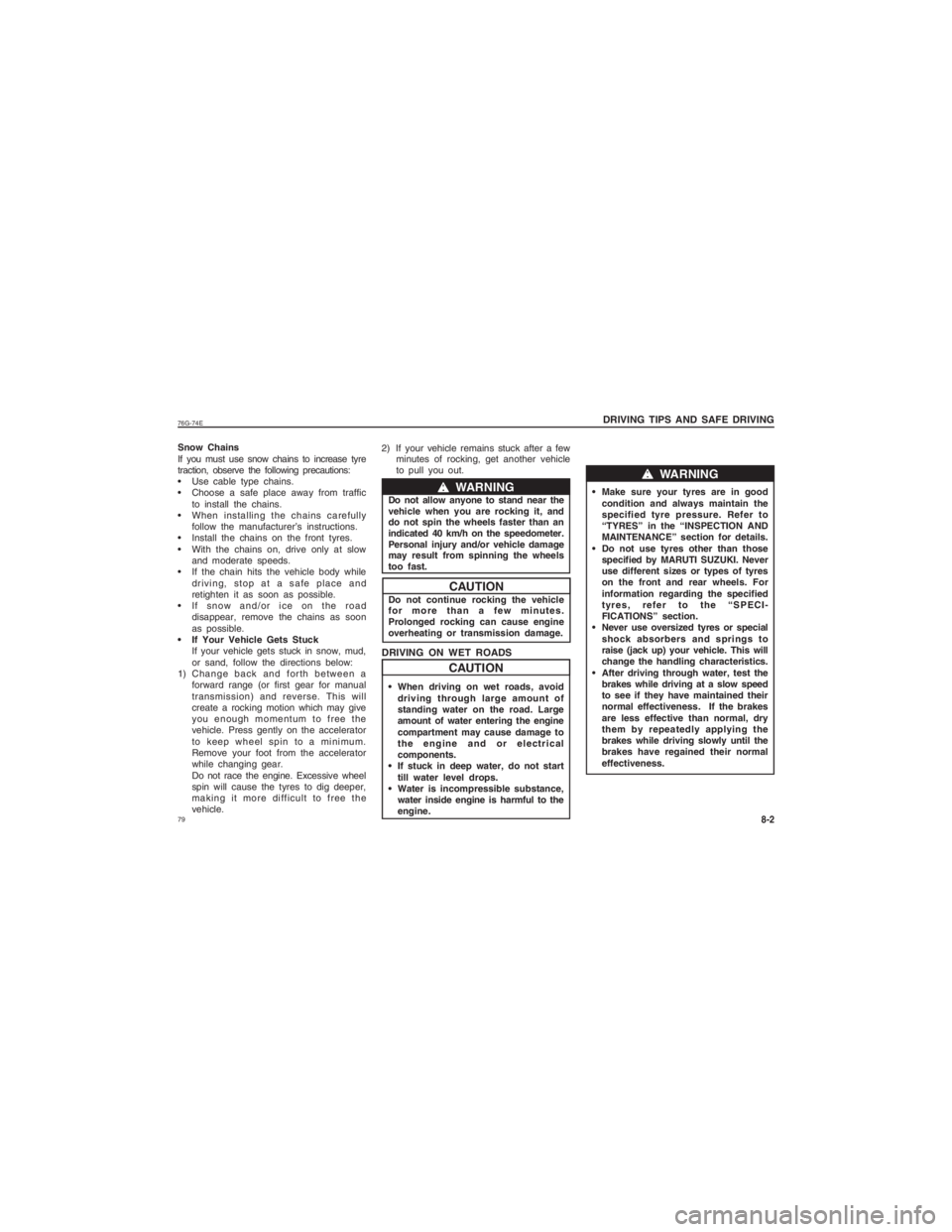
7976G-74ESnow Chains
If you must use snow chains to increase tyre
traction, observe the following precautions:
Use cable type chains.
Choose a safe place away from traffic to install the chains.
When installing the chains carefully follow the manufacturer’s instructions.
Install the chains on the front tyres.
With the chains on, drive only at slow and moderate speeds.
If the chain hits the vehicle body while
driving, stop at a safe place and
retighten it as soon as possible.
If snow and/or ice on the road disappear, remove the chains as soon
as possible.
If Your Vehicle Gets Stuck If your vehicle gets stuck in snow, mud,
or sand, follow the directions below:
1) Change back and forth between a forward range (or first gear for manual
transmission) and reverse. This will
create a rocking motion which may give
you enough momentum to free the
vehicle. Press gently on the accelerator
to keep wheel spin to a minimum.
Remove your foot from the accelerator
while changing gear.
Do not race the engine. Excessive wheel
spin will cause the tyres to dig deeper,
making it more difficult to free the
vehicle. 2) If your vehicle remains stuck after a few
minutes of rocking, get another vehicle
to pull you out.
Do not allow anyone to stand near the
vehicle when you are rocking it, and
do not spin the wheels faster than an
indicated 40 km/h on the speedometer.
Personal injury and/or vehicle damage
may result from spinning the wheels
too fast.
Do not continue rocking the vehicle
for more than a few minutes.
Prolonged rocking can cause engine
overheating or transmission damage. Make sure your tyres are in good
condition and always maintain the
specified tyre pressure. Refer to
“TYRES” in the “INSPECTION AND
MAINTENANCE” section for details.
Do not use tyres other than those specified by MARUTI SUZUKI. Never
use different sizes or types of tyres
on the front and rear wheels. For
information regarding the specified
tyres, refer to the “SPECI-
FICATIONS” section.
Never use oversized tyres or special
shock absorbers and springs to
raise (jack up) your vehicle. This will
change the handling characteristics.
After driving through water, test the
brakes while driving at a slow speed
to see if they have maintained their
normal effectiveness. If the brakes
are less effective than normal, dry
them by repeatedly applying the
brakes while driving slowly until the
brakes have regained their normal
effectiveness.
ww ww
w WARNINGCAUTION
8-2
ww
ww
w WARNING
DRIVING TIPS AND SAFE DRIVING
DRIVING ON WET ROADS
When driving on wet roads, avoid driving through large amount of
standing water on the road. Large
amount of water entering the engine
compartment may cause damage to
the engine and or electrical
components.
If stuck in deep water, do not start till water level drops.
Water is incompressible substance, water inside engine is harmful to the
engine.
CAUTION
Page 79 of 139
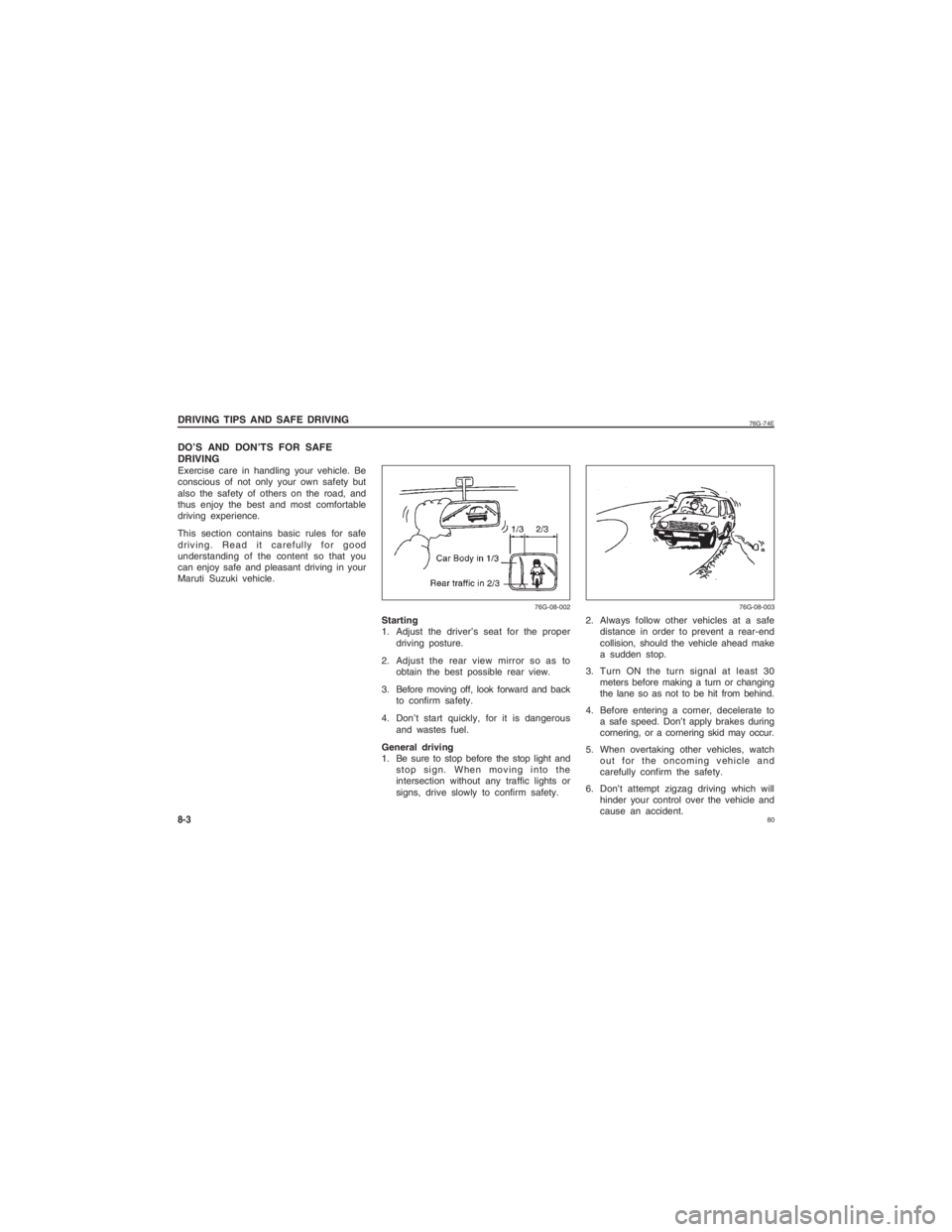
80
76G-74E
DO’S AND DON’TS FOR SAFE
DRIVINGExercise care in handling your vehicle. Be
conscious of not only your own safety but
also the safety of others on the road, and
thus enjoy the best and most comfortable
driving experience.
This section contains basic rules for safe
driving. Read it carefully for good
understanding of the content so that you
can enjoy safe and pleasant driving in your
Maruti Suzuki vehicle.Starting
1. Adjust the driver’s seat for the properdriving posture.
2. Adjust the rear view mirror so as to obtain the best possible rear view.
3. Before moving off, look forward and back to confirm safety.
4. Don’t start quickly, for it is dangerous and wastes fuel.
General driving
1. Be sure to stop before the stop light and stop sign. When moving into the
intersection without any traffic lights or
signs, drive slowly to confirm safety.8-3DRIVING TIPS AND SAFE DRIVING
2. Always follow other vehicles at a safedistance in order to prevent a rear-end
collision, should the vehicle ahead make
a sudden stop.
3. Turn ON the turn signal at least 30 meters before making a turn or changing
the lane so as not to be hit from behind.
4. Before entering a corner, decelerate to a safe speed. Don’t apply brakes during
cornering, or a cornering skid may occur.
5. When overtaking other vehicles, watch out for the oncoming vehicle and
carefully confirm the safety.
6. Don’t attempt zigzag driving which will hinder your control over the vehicle and
cause an accident.
76G-08-002 76G-08-003
Page 80 of 139
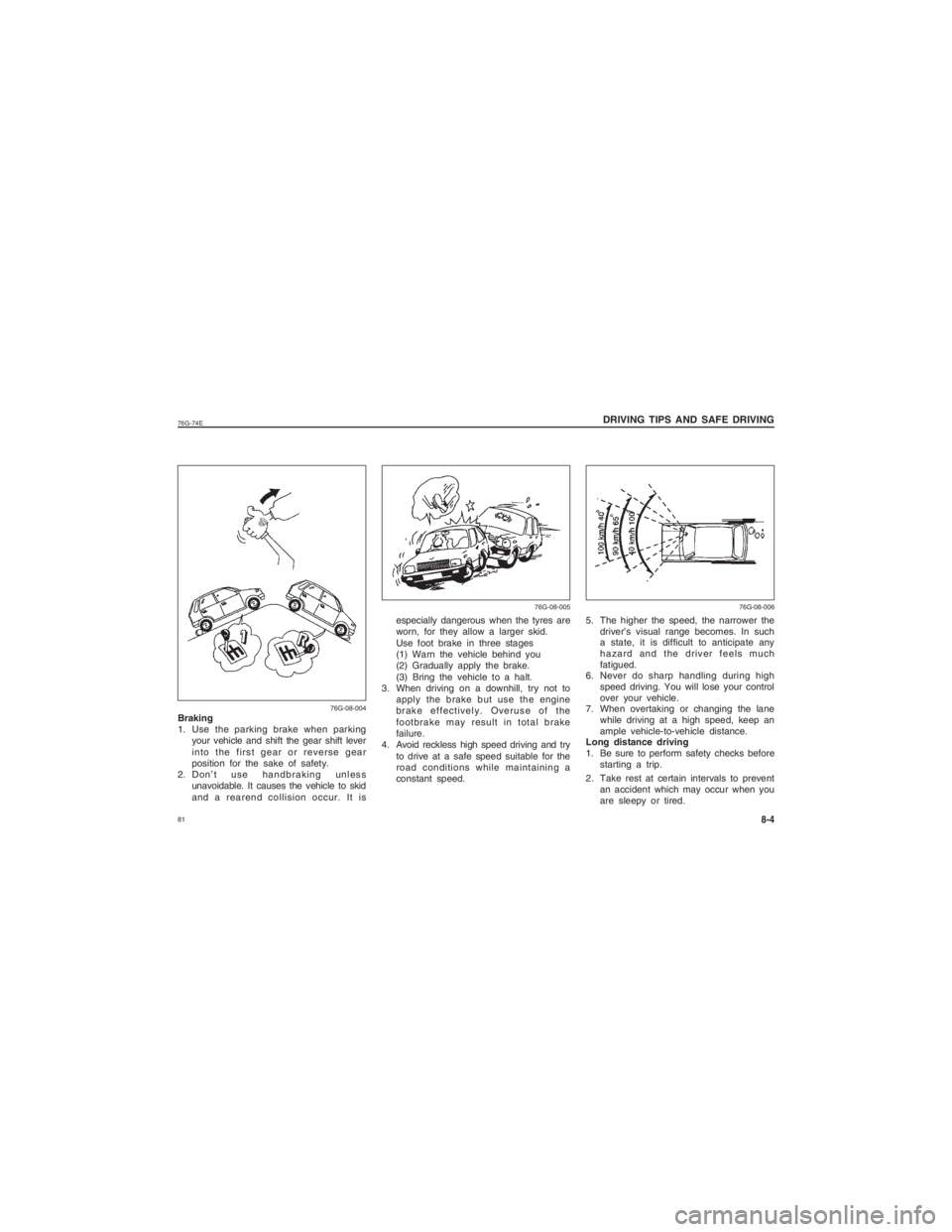
8176G-74E
especially dangerous when the tyres are
worn, for they allow a larger skid.
Use foot brake in three stages
(1) Warn the vehicle behind you
(2) Gradually apply the brake.
(3) Bring the vehicle to a halt.
3. When driving on a downhill, try not to apply the brake but use the engine
brake effectively. Overuse of the
footbrake may result in total brake
failure.
4. Avoid reckless high speed driving and try
to drive at a safe speed suitable for the
road conditions while maintaining a
constant speed. 5. The higher the speed, the narrower the
driver’s visual range becomes. In such
a state, it is difficult to anticipate any
hazard and the driver feels much
fatigued.
6. Never do sharp handling during high
speed driving. You will lose your control
over your vehicle.
7. When overtaking or changing the lane
while driving at a high speed, keep an
ample vehicle-to-vehicle distance.
Long distance driving
1. Be sure to perform safety checks before
starting a trip.
2. Take rest at certain intervals to prevent an accident which may occur when you
are sleepy or tired.
Braking
1. Use the parking brake when parking
your vehicle and shift the gear shift lever
into the first gear or reverse gear
position for the sake of safety.
2. Don’t use handbraking unless unavoidable. It causes the vehicle to skid
and a rearend collision occur. It is
8-4
DRIVING TIPS AND SAFE DRIVING
76G-08-004 76G-08-005 76G-08-006